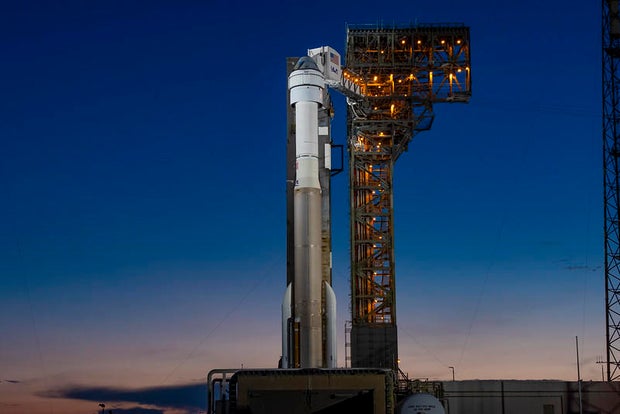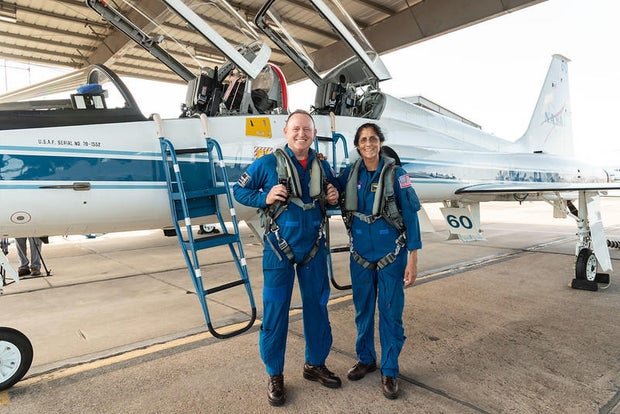An Atlas 5 rocket carrying astronauts for the first time in six decades was prepared to take off on Monday night to boost Boeing’s long-delayed Starliner manned spacecraft in orbit for its first piloted test flight to the International Space Station.
Years late and more than a billion dollars over budget, Starliner is Boeing’s answer to SpaceX’s Crew Dragon, an already operational spacecraft that has carried 50 astronauts, cosmonauts and civilians to orbit in 13 flights, 12 of them to the space station.
United Launch Alliance
NASA funded the development of both spacecraft to ensure the agency would be able to launch crews to the outpost even if a company’s ferry became stranded for any reason.
Astronauts ready for launch
Although Boeing took longer than expected to prepare its spacecraft for crew flights, it was all systems go on Pad 41 at Cape Canaveral Space Force Station at 10:34 p.m. EDT.
At the controls will be the mission commander Barry “Butch” Wilmore and Sunita Williamsboth veteran Navy test pilots and active-duty NASA astronauts, with four previous space flights to their credit, 11 spacewalks between them, and a combined 500 days in orbit.
NASA
Like SpaceX’s Crew Dragon, Starliner is equipped with a “full envelope” abort system capable of quickly propelling the capsule away from its booster in the event of a serious malfunction anywhere from the launch pad to orbit. .
But if all goes well, Atlas 5’s Centaur upper stage will launch Starliner into a preliminary orbit 15 minutes after liftoff. The astronauts will then monitor two rapid thruster firings to adjust the spacecraft’s orbit before taking turns testing the spacecraft’s computer-assisted manual control system.
As with any other space station rendezvous, Starliner will approach the laboratory from behind and below, rising to a point directly in front of the outpost and then moving to dock at the front door of the Harmony module at 12:46 p.m. Wednesday. .
During final approach, Wilmore and Williams will retest the capsule’s manual controls, ensuring that future crews can adjust the spacecraft’s trajectory or orientation at their own discretion if necessary.
Starliner is also equipped with a fully manual backup system that allows the crew to directly command the spacecraft’s thrusters using a joystick-style hand controller, bypassing the spacecraft’s flight computers. Wilmore and Williams will test this system after departing the station around May 15 to begin the journey back to Earth.
If the Starliner test flight goes well, NASA managers plan to certify it for routine crew rotation flights, launch a Crew Dragon and a Starliner each year to deliver long-duration crew members to the station for six-month missions. .
“An absolutely critical milestone”
Jim Free, NASA associate administrator for space operations, called the Starliner Crew Flight test, or CFT, “an absolutely critical milestone.”
“Let me remind everyone again, this is a new spacecraft,” he told reporters last week. “We certainly have some unknowns in this mission, we may find things we don’t expect. But our job now is to remain vigilant and keep looking for problems.”
While he said he was confident the Starliner was up to the task, Free said he didn’t want to “get too far ahead” as the crew has yet to complete a successful mission. But “when we do,” he added, “and when we certify Starliner, the United States will have two unique human space shuttles that provide critical redundancy for access to the ISS.”
But it hasn’t been easy.
Following the space shuttle’s retirement in 2011, NASA awarded two Commercial Crew Program contracts in 2014, one to SpaceX valued at $2.6 billion and another to Boeing for $4.2 billion, to stimulate space shuttle development. development of independent spacecraft capable of transporting astronauts to and from the International Space Station.
The target date for CCP’s first piloted flights was 2017. Funding shortfalls in Congress and technical hurdles delayed development, including an explosion during a ground test that destroyed a SpaceX Crew Dragon.
But the California rocket builder finally began piloted flights in May 2020, successfully launching two NASA astronauts on a Crew Dragon test flight to the space station.
Since then, SpaceX has launched eight operational crew rotation flights to the station, three research missions to the laboratory funded by the Houston-based company. Axiom Space it is a purely commercial, a trip for two men and two women to low Earth orbit paid for by pilot and billionaire businessman Jared Isaacman. In total, 50 people flew into orbit aboard the Crew Dragons.
The story has been different for Boeing’s Starliner.
During an initial unpiloted test flight in December 2019, a software error prevented the ship’s flight computer from loading the correct launch time of its counterpart aboard Atlas 5.
United Launch Alliance
As a result, the required orbit insertion burn did not happen in time and due to unrelated communications problems, flight controllers were unable to regain control in time to proceed with a rendezvous at the space station.
The software issues were resolved after the Starliner landed, along with a variety of other issues that came to light in a post-flight review. Boeing opted to conduct a second test flight, at its own expense, but the company found propulsion system valves stuck in the Starliner’s service module. Engineers were unable to resolve the issue and the capsule was removed from the Atlas 5 and transported back to the processing facility for troubleshooting.
Engineers eventually attributed the problem to moisture, likely due to high humidity and torrential rain after launch from the pad, which chemically reacted with the booster’s propellant to form corrosion. Corrosion prevented the valves from opening on command.
To clear the way for launch the following May, valves on a new service module were replaced and the system was modified to prevent water intrusion onto the launch pad. Starliner’s second test flight in May 2022 was a success, docking with the space station as planned and returning to Earth with a precision landing.
But after the flight, engineers discovered new problems: problems with the parachute harness connectors and concerns about protective tape wrapped around the wiring that could catch fire in the event of a short circuit.
Work to fix these problems pushed the first manned flight from 2023 to 2024. Ultimately, Boeing spent more than $1 billion of its own money to pay for the additional test flight and corrective actions.


























